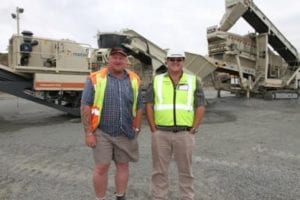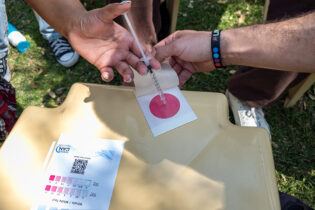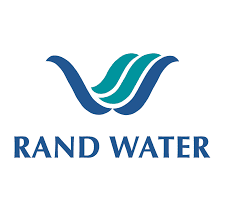From left to right are WK Crushing’s site manager, Dirk van Schalkwyk, and Barloworld Equipment Metso Mobile’s sales consultant, Lantie van der Merwe. In the background is WK Crushing’s Metso Lokotrack LT1100 cone crusher and screen on one chassis (forming the closed circuit) feeding into the LT7150 VSI
A Metso Lokotrack train is meeting high tonnage aggregate demands on a Mpumalanga road rehabilitation project, with the contractor, WK Crushing, achieving consistent downstream product quality. Work is now at an advanced stage on a major road upgrade on the R50 between Leandra and Standerton, which is being rebuilt on a solid foundation by Bloemfontein based contractor, Nucon Roads & Civils. WK Construction Group entity, WK Crushing, was appointed as the crushing and screening contractor and has been responsible for supplying all road aggregate materials on this fast-tracked rehabilitation project, which commenced in January 2012 and is due for completion by the end of March 2013. Meeting the material specifications over this 26 km section, WK Crushing’s contract scope entails the dedicated supply of approximately 230 000 t of -38 mm G2 base course as well as plus 9.5 mm and 19 mm road stone amounting to a further 3 000 and 8 000 t, respectively. By November 2012, the bulk of the G2 quantities had been supplied to site, with all road stone materials sourced from a WK registered dolerite borrow pit situated outside the town of Leandra. This pit is currently being mined to around 10.5 m from surface and has substantial dolerite reserves below this depth to meet other downstream WK material supply contracts in the region for concrete, road aggregate or pipeline bases. WK Crushing is a leading contractor in the crushing and screening sector, and over the years has successfully completed a number of quarrying and crushing operations in mining, concrete readymix, road building and civil engineering within South Africa as well as cross-border, backed by a modern equipment fleet. WK’s mobile process train set-up at the Leandra borrow pit starts with a Metso Lokotrack LT105 primary jaw crusher feeding into a secondary cone crusher and from there to a tertiary Metso LT1100 cone crusher and screen on one chassis (forming the closed circuit), with a Metso LT7150 VSI (vertical shaft impactor) performing final stage crushing. These Metso units communicate via onboard IC (Intelligent Control) automation and work as one seamlessly integrated system. Automation makes it possible to run machines at constant, specific performance rates to achieve the best cost per aggregate tonne. The IC system also prevents overloading caused by process fluctuations, as well as from damage caused by misuse. Advanced fault diagnostics immediately pinpoint any potential problem, so there is minimal standing time. In the closed circuit, +38 mm material is fed to the LT1100 cone for reduction to -38 mm and then passes through the VSI. Screened material below -38 mm also passes through the VSI to generate fines material, an essential ingredient for optimum road base compaction. “Although placed at the end of the process train, the VSI has the most important job to do in performing final product shaping. Plus being at the tail end, the LT7150 must keep place with the ongoing material throughput flowing from the primary stage,” explains Dirk van Schalkwyk, WK Crushing’s site manager.During G2 production, WK Crushing’s train has typically averaged around 170 to 180 tph and up to 210 tph at peak, depending on variables in blasted material sizes and densities. “And we’ve achieved these figures with consistently high availability from our Metso units,” he continues.
Barmac VSI Powered by a Cat Acert C13 engine, Metso’s LT7150 is the first Lokotrack model to be fitted with a Metso Barmac VSI crusher on board, in this instance a B7150M unit. Configured as a VSI unit, the LT7150 is an ideal third or fourth stage crusher, which combines high velocity impact crushing with attrition crushing to produce cubical aggregates, road base and prime manufactured sand. In fact, field tests have proven that less cement can be used in road bases and stronger concrete created by using Barmac VSI products. Waste products such as steel slag, which is commonly used as an aggregate in South African road construction, can also be optimally processed via VSI technology. “Barmac VSIs are unique among all vertical shaft impactors due to their pure rock-on-rock crushing principle, an autogenous crushing process that produces the best cubically shaped aggregates on the market today,” explains Barloworld Equipment Metso Mobile sales consultant, Lantie van der Merwe. “Compared to other OEM designs, this means that impeller shoes or impact anvils are not needed to achieve reduction, which in turn helps to lower overall operating costs.” Metso’s VSI design centres on its Barmac DTR deep rotor. The development of deep rotor technology, combined with long-life wear parts and segmented tip assemblies dramatically reduces down-time associated with wear part replacement. The LT7150’s Barmac VSI 840 DTR rotor accepts feed size up to 66 mm, accelerates material and continuously discharges it into the crushing chamber, with particle exit velocities ranging between 45 to 70 metres per second. This high-velocity impact crushing, together with high-pressure attrition grinding, results in superior concrete and asphalt aggregates, with the ability to fine-tune this process by simply changing rotor speed. “Experience has shown that the key to profits in the aggregate production industry lies in the ability to produce consistent products of high quality, which in turn leads to the construction of durable roads that last,” adds Van Schalkwyk.








